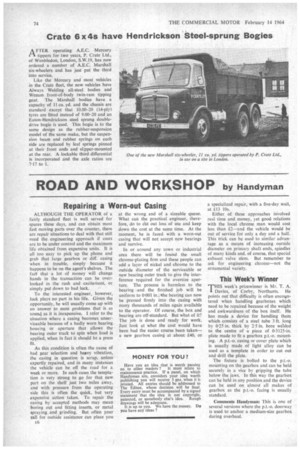ROAD AND WORKSHOP by Handyman
Page 76

If you've noticed an error in this article please click here to report it so we can fix it.
Repairing a Worn-out Casing
ALTHOUGH THE OPERATOR of a fairly standard fleet is well served for spares these days, and can obtain most fast moving parts over the counter, there are repair situations to deal with that still need the engineering approach if costs are to be under control and the maximum life obtained from expensive units. It is all too easy to pick up the phone and grab that large gearbox or dill, casing when in trouble, simply because it happens to be on the agent's shelves. The fact that a lot of money will change hands in the transaction can be overlooked in the rush and excitement, or simply put down to bad luck.
To the interested . engineer, however, luck plays no part in his life. Given the opportunity, he will usually come up with an answer to most problems that is as sound as it is inexpensive. I refer to the situation where a casing becomes unserviceable because of a badly worn bearing housing or aperture that allows the bearing outer track to spin when load is applied, when in fact it should be a press fit.
As this condition is often the cause of bad gear selection and heavy vibration, the casing in question is scrap, unless expertly repaired, and in many instances the vehicle can be off the road for a week or more. In such cases the temptation is very strong to go for that new part on the shelf just two miles away, and with pressure from the operating side this is often the quick, but very expensive action taken. To repair the casing by accepted methods may mean boring out and fitting inserts, or metal spraying and grinding. But often your call for outside assistance can place you at the wrong end of a sizeable queue. What can the practical engineer, therefore, do to ctit out loss of use and keep down the cost at the same time. At the moment, he is faced with a worn-out casing that will not accept new bearings and survive.
In or around any town or industrial area there will be found the small chrome-plating firm and these people can add a layer of nickel and chrome to the outside diameter of the serviceable or new bearing outer track to give the interference required for the oversize aperture. The process is harmless to the bearing and the finished job will be uniform to 0-001 in.; he bearing can now be pressed firmly into the casing with many thousands of miles again available to the operator. Of course, the box and bearing are off-standard. But what of it? The job is done and ready for work. Just look at what the cost would have been had the easier course been taken— a new gearbox casing at about £40, or
a specialized repair, with a five-day wait, at £13 10s.
Either of these approaches involved real time and money, yet good relations with the local chrome man would cost less than £2---and the vehicle would be out of service for only a day and a half. This trick can be used to similar advantage as a means of increasing outside diameter on primary shaft ends, spindles of many kinds and, of course, that special exhaust valve stem. But remember to ask for engineering chrome—not the ornamental variety.
This Week's Winner
THIS week's prizewinner is Mr. T. A. I Davies, of Corby, Northants. He points out that difficulty is often encountered when handling gearboxes which need to be repaired because of the weight and awkwardness of the box itself. He has made a device for handling them which consists of a steel tube 3 ft. long by 0-25 in. thick by 2.5 in, bore welded to the centre of a piece of 0-3125-in. plate made to fit a gearbox p.t.-o. mounting. A p.t.-o. casing or cover plate which is usually made of light alloy can be used as a template in order to cut out and drill the plate.
The fixture is bolted to the p.t.-o. mounting on the gearbox and can be held securely in a vice by gripping the tube below the jaws. In this way the gearbox can be held in any position and the device can be used on almost all makes of gearbox as the p.t.-o. facing is usually standard.
Comments Handyman: This is one of several versions where the p.t.-o. doorway is used to anchor a medium-size gearbox during overhaul.
















































































































































































